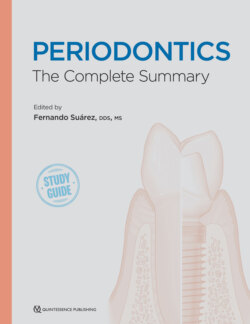Читать книгу Periodontics - Fernando Suarez - Страница 14
На сайте Литреса книга снята с продажи.
CEMENTUM
ОглавлениеCementum is the second mineralized tissue of the attachment apparatus. It is an avascular mineralized connective tissue that surrounds the dentin at the level of the dental root. Its primary function is to allow for the anchorage of Sharpey fibers that will keep the tooth in the alveolus as well as to adapt and protect during tooth wear and movement. The thickness of cementum increases with age. Also, apical portions of the dental root present with thicker cementum than the coronal counterparts.5 The CEJ is the anatomical area where the crown meets the root. Schroeder and Scherle10 described three types of relationships between cementum and enamel: edge to edge; cementum covering the enamel; or a gap between both structures where dentin is exposed. The most prevalent interrelation is cementum covering the enamel, followed by edge to edge and gap.11
Based on the presence of cementocytes embedded in its extracellular matrix, the cementum can be classified as cellular or acellular. In addition, the fibers that form the cementum will contribute to the classification of the different types5 (Table 1-3).
TABLE 1-3 Features of the different types of cementum
As in the formation of the PDL, cementum starts developing in a prefunctional stage prior to the eruption of the tooth. After the crown is formed, the cells of the inner and outer enamel epithelium that constitute the cervical loop will proliferate deeper into the ectomesenchyme driving the development of the dental root. This structure is known as the Hertwig epithelial root sheath (HERS). The most apical portion of the HERS, which encloses the dental papilla, is known as the epithelial diaphragm. Cells from the HERS induce the differentiation of the dental papilla cells in a coronoapical direction to become odontoblasts that will form the dentin of the root. The number and morphology of the dental roots will be determined by the disposition of the HERS. The cementum, the mineral portion of the root facing the PDL, is formed by cementoblasts that are believed to originate from the ectomesenchymal cells of the dental follicle after the disintegration of the HERS. Cells from the HERS produce different proteins and mediators to induce the differentiation of the dental follicle cells into cementoblasts. Fibroblasts in the area produce bundles of collagen fibrils that form fringe fibers, and these are anchored to the tooth by the deposition of a mineral matrix by cementoblasts.
When the tooth is near to entering its functional stage, a shift in the formation of cementum can be seen from acellular extrinsic fibrillar cementum to mixed stratified cementum. The rate of growth of cementum is 1.5 to 3 µm per year.12
Even though the previously described formation of cementum is the most accepted theory, an alternative hypothesis has been proposed. This theory suggests an enhanced role of the HERS in the formation of cementum through the differentiation of HERS cells to become cementoblasts.13
The chemical composition of cementum is similar to bone with approximately one-third organic material, one-third mineral phase, and one-third water. The primary inorganic structure of cementum is also hydroxyapatite crystals. The organic material is composed of collagen, glycoproteins, and proteoglycans (Box 1-1).
BOX 1-1 Organic chemical composition of cementum
| Collagenous proteins | Collagen I (90%)Collagen III (5%) |
| Noncollagenous proteins | Glycoproteins |
| Glycolipids | |
| Proteoglycans | |
| Enamel-related proteins |
